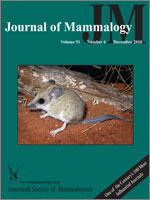Radiotelemetry is used to quantify behavioral, ecological, and physiological variables of animals. Because of technological limitations, relative transmitter size generally increases with decreasing body mass of the study animal, and the recommended transmitter mass of <5% of body mass often prohibits work on small mammals. We compared burst running speed, important for predator avoidance, in 2 small marsupials, Sminthopsis crassicaudata (fat-tailed dunnart) and Planigale gilesi (Giles' planigale), without and with implanted transmitters. In both species maximum running speed was not affected by the transmitters, whose mass ranged from 6.4% to 14.1% of body mass. Further, relative transmitter mass was not correlated with maximum running speed. Consequently, transmitters well above 5% of body mass need not affect locomotor performance of small terrestrial mammals.
How to translate text using browser tools
16 December 2010
Do implanted transmitters affect maximum running speed of two small marsupials?
A. Daniella Rojas,
Gerhard Körtner,
Fritz Geiser
ACCESS THE FULL ARTICLE

Journal of Mammalogy
Vol. 91 • No. 6
December 2010
Vol. 91 • No. 6
December 2010
internal transmitters
maximum running speed
Planigale gilesi
Sminthopsis crassicaudata




